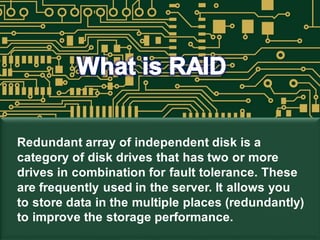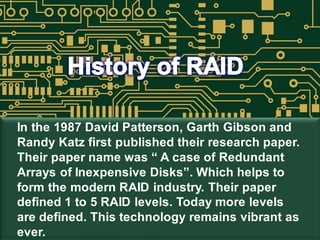Understanding RAID Controller
- 1. RAID means redundant array of independent disk. It is a type of storage technology. It combines multiple disk component into a logical unit. Data is distributed across several RAID levels.
- 2. Redundant array of independent disk is a category of disk drives that has two or more drives in combination for fault tolerance. These are frequently used in the server. It allows you to store data in the multiple places (redundantly) to improve the storage performance.
- 3. In the 1987 David Patterson, Garth Gibson and Randy Katz first published their research paper. Their paper name was ˇ° A case of Redundant Arrays of Inexpensive Disksˇ±. Which helps to form the modern RAID industry. Their paper defined 1 to 5 RAID levels. Today more levels are defined. This technology remains vibrant as ever.
- 4. Number of standard schemes are evolved those are refer as levels. Originally there ware five levels but today it vibrantly evolved more levels. ItˇŻs level and original data format is standardize storage networking industry association (SNIA).
- 5. RAID means redundant array of independent disk. It is a type of storage technology. It combines multiple disk component into a logical unit. Data is distributed across several RAID levels.
- 6. Different architecture are provided by RAID followed by each architecture provides performance, capacity and tolerance. These levels are 0, 1, 2, 3, 4, 5 and 6.
- 7. Provides data striping (spreading out files across multiple disk drives) but without redundancy. It highly improves the performance. In certain case if one drive is fail then all data is lost. Data is fragmented is called blocks. Number of block is dedicated to the stripe size. It is configuration parameter of array. Block is written in the same sector simultaneously in the different drives.
- 8. Level 1 provides the twice the read transaction rate in the same disk. Write transaction rate is also same. Write request update the stripe of both drives. The array is continue to operate as long as at one drive is operating. It has separate controller in each drive for simultaneously reads called multiplexing.
- 9. Strip data at the bit level rather than the block level. In this level all disk spindle rotating in a synchronized way that each sequential bit on a different drive. Across these bits hamming code is calculated.
- 10. It provides byte level striping with a dedicated parity disk. It canˇŻt service simultaneously it is used rarely. Parity is calculated and stored in the dedicated parity drive.
- 11. Commonly used implementation of RAID is block level striping with a dedicated parity disk. If disk fails then parity create a replacement. Disadvantage of it creates bottleneck.
- 12. It provides data striping at the block level. It performs excellently in the good fault tolerance. It requires data and all drives but one to be operate. Array is not destroyed in a single disk failure. In a single disk failure it reduce the entire performance. RAID 5 requires at least three disk.
- 13. It is similar to RAID 5 except instead of one parity block per stripe. With two independent parity block RAID 6 can survive loss of two in among the group of disk.
- 14. RAID concept is present from in 1986 and it is installed in the million of configuration. It lacks of the standard. RAID implementation is proprietary and unique to every vendor.
- 15. RAID is implemented in the server by a software called JBOD (just a bunch of disks). It acts as a logical volume manager it manage the parity calculation.
- 16. These are the cards that can be added to a server and performs the offload of overloaded RAID CPU. It is a better solution for a single server. For managing the mirror data it CPU spend no processing power. It uses either internal drives or JBOD.
- 17. It consist of two high performance and redundant RAID controller. They support multiple RAID levels and different drive types and speeds. Storage array also have snap shot, volume copy etc. There are different types of RAID controller like IBM RAID controller.
- 18. 188-M Technology Drive Irvine CA 92618 Tel: (949) 788-9939 Fax: (949) 788-9940 http://www.shopricom.com



















